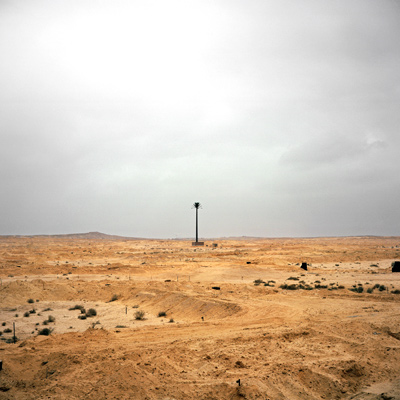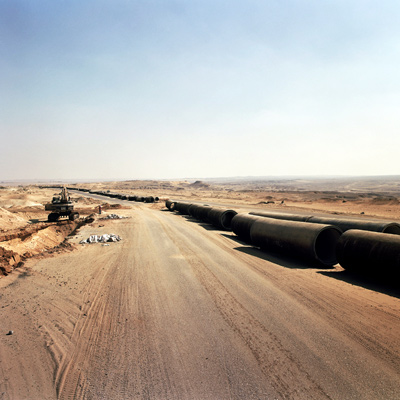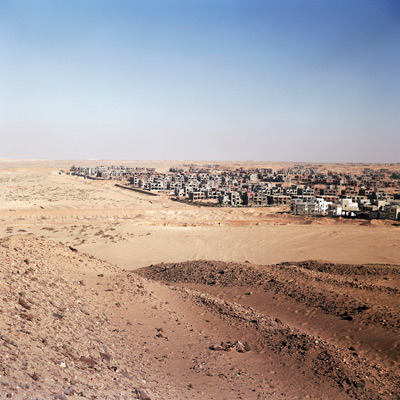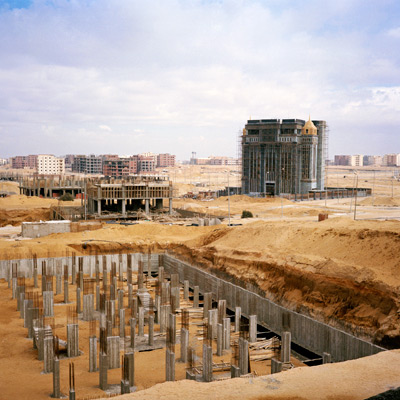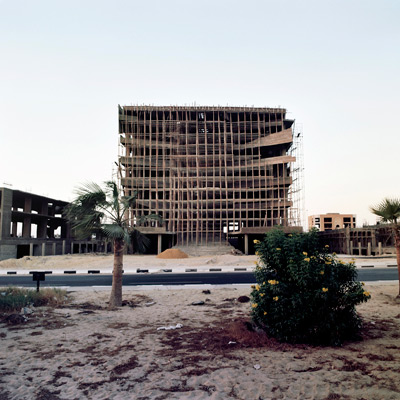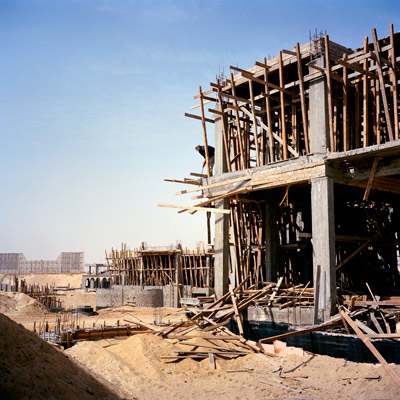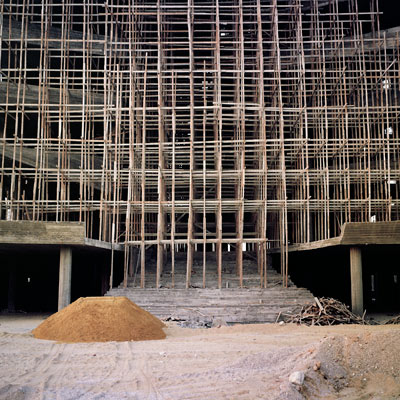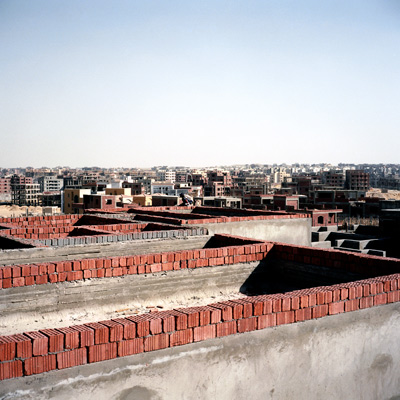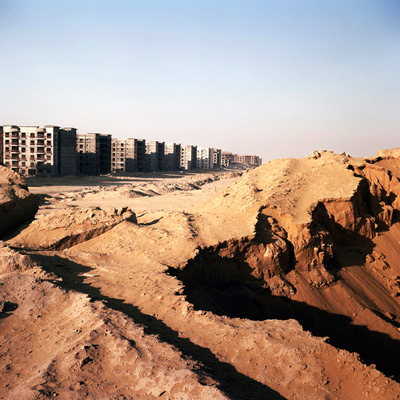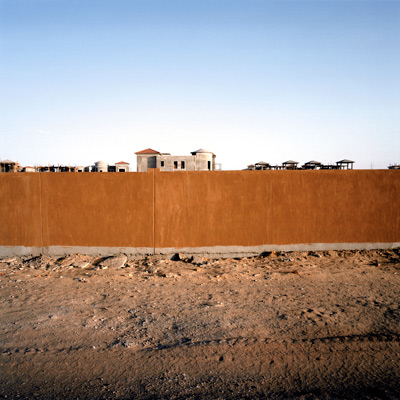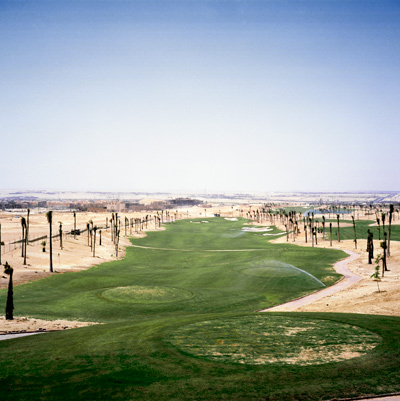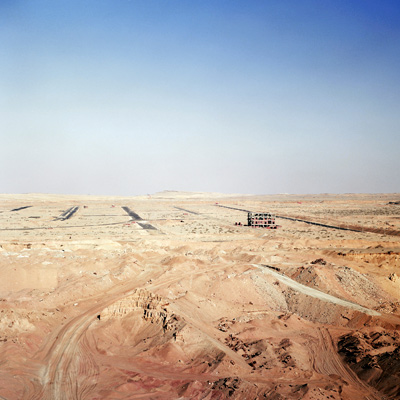Cairo Divided
A Megacity Turns Itself Inside Out
To get under the skin of modern Cairo, a megacity too big for its borders, you need to climb above it.
The best place to start is on the traffic-swamped 26th July flyover that wends its way into the sky from downtown before sweeping westwards across the Nile. Passing motorists can see a range of the ancient capital’s many faces angled up towards them from here: a discordant clatter of the genteel and kitsch on Zamalek Island; faded technicolour splashed over the state circus on the Corniche; the sound of brash motorbikes and franchised coffee outlets gurgling up from the new-build suburb of Mohandiseen.
But it’s beyond all of this, out near the ring road, that today’s Cairo really begins parking itself at the roadside for inspection. Here the greys of the old city fall away to be replaced by mile upon mile of soaring redbrick apartment blocks, close enough for passing motorists to peer right into each family living room. These buildings jostle for space on impossibly thin parcels of what was once agricultural land, all permanently half-finished and with clumps of steel rebars sprouting precariously from their rooftops, ready to shoulder the next illegally-constructed storey.
There are few exits on this section of the highway; most of those who live in the informal settlements below – known as ashwa’iyat, an Arabic word which means random or haphazard – don’t have cars, and the Egyptians who do drive would rarely have cause to visit them. This road has another destination in mind and for a few moments, when the flyover veers slightly to the left and the four thousand year old pyramids of Giza suddenly appear gloriously on the horizon, it seems as if the nation’s pharaonic past might just be it. But the road quickly changes course again, ploughing through acres of barren desert and leaving old Cairo far behind. A first-time traveller could be forgiven for asking himself what anybody could possibly be driving towards out here, where addresses can only be expressed in motorway distance markers and the monotony of sand is broken up by nothing more than an occasional pile of rubble.
The answer lies scrawled on the advertising billboards above. ‘Welcome to the future of Cairo’, they read. ‘Where life is more complete’.
This is a story about a city so large that it had to turn itself inside out, transforming its periphery into its core whilst condemning the previous centre to a life on the margins. It’s a process that began long before this year’s revolution and is continuing well beyond it, ripping apart old social and political fabrics and giving birth to a web of contradictions where the advance of private capital is marshalled by an aggressively retreating state, gated compounds for the elites are reimagined as inclusive national projects, isolation gets marketed as community and plush green golf courses can rise miraculously from some of the most arid land on earth.
Perhaps most significantly of all it’s a process which has burst the historical banks of a metropolis that for fourteen centuries grew only within a pair of stubbornly persistent natural confines: the Moqattam clifftops to the east and the Saharan desert, the threshold of which is guarded by the sphinx, to the west. A population explosion straitjacketed by geography has given rise to one of the densest urban areas in the world; today Cairo – the biggest city in Africa and the Middle East – creaks under the weight of up to 20 million people, more than the entire populations of Libya, Lebanon and Jordan combined. But now the contours of the city, both spatial and psychological, are changing. Way beyond its former limits, new developments are materialising faster than you can count them; gilt-edged satellite cities that aim to one day become the nucleus of the city itself and offer not just a new piece of property but a whole new way of life – for those that can afford it.
Supporters of the satellite cities project – and they can count the regime of former president Hosni Mubarak among their number, as well as numerous big-name international investors and hundreds of thousands of Cairo’s richest residents – see the desert as a chance to rebuild the iconic city from scratch, free from the congestion, crime and chaos which they believe has blighted the capital beyond repair. Yet others fear that as Cairo is reshaped many will be left behind, planted on the wrong side of an urban perimeter that weaves to the beat of foreign finance, opulent villas and sentry towers watching over increasingly-higher walls. For many, the grassroots uprising that began in January 2011 is far from over, and the satellite cities concept stands squarely in opposition to a revolution still struggling for economic and social justice. Suffocated by poverty and unemployment and divided by political uncertainty, this city often feels as if it is teetering on the brink of implosion; since Mubarak’s fall a wave of new legal challenges to the elite desert development programme has landed some of its orchestrators in jail and thrown a multitude of Egypt’s top real estate companies into turmoil. Yet more and more advertising billboards offering snatched glimpses of paradise keep getting hauled up onto the 26th July flyover, thrusting those driving below ceaselessly into the future. “You may call them satellite cities, but they’re not satellites anymore” claimed a former government minister responsible for the corporate-branded transformation of Egypt’s urban soul. “Now they’ve become the planets themselves.”
It’s a hot dusty day in late April 2010, and Ahmed Seif is breaking out in a sweat as he tries to manoeuvre a full-sized speedboat through a single pair of doors. His eight exhausted assistants have been unsuccessfully experimenting with different angles for thirty minutes now, and look dangerously close to mutiny. “Right, let’s try one more time with the boat on its side,” demands Ahmed, ignoring the contemptuous looks being thrown in his direction by the hired muscle. After some fairly frantic shouting and a painful scraping of metal the boat is finally propelled inside and almost immediately knocks over an artfully-designed pyramid of salmon canapés. Ahmed shakes his head disbelievingly. “Let’s get this over and done with,” he sighs.
The boat is part of a sales stand for the Wadi Degla Real Estate company, one of over forty development firms who have set up shop at the annual ‘Next Move’ conference, the biggest property expo in Egypt. Competition here is fierce and most companies are spending the opening morning sprucing up their stands with something a little bit special in the hope of attracting the attention of visitors, 27,000 of whom will pass through the conference centre over the next three days. Palm Hills has created a lavishly landscaped fake lawn replete with a built-in Starbucks; further along the Porto Cairo display is being attended to by a full travelling circus comprising a juggler, two trumpeters and one furry mascot of unidentified origin that may or may not be a rat. Not content with offering a speedboat for visitors to admire as they leaf through the company’s glossy brochures, Wadi Degla has also ordered in a genuine Ferrari to sit next to it. Next door a rival set of staff at La Vista are throwing envious looks towards the Ferrari and grimacing at their own marketing ruse – a somewhat lacklustre classical string quartet.
Cellists, cars and complimentary coffees don’t come cheap, but for the companies involved in ‘Next Move’ the cost of such gimmicks is a small price to pay when set alongside the prize at hand: a share of the mammoth Egyptian real estate market, which currently accounts for $14 billion of the country’s GDP and has clocked up yearly growth rates of up to 22% in the past half-decade. To see where that growth is coming from you need only glance at the centrespread of the conference brochure, which consists of a map detailing the physical location of all the construction projects being undertaken by companies at ‘Next Move’. Three of them are in Cairo; 64 others lie deep in the desert sand beyond. Some of these developments feature the names of internationally-renowned architects like Zaha Hadid; others are colossal enough to be considered fully-fledged metropolises in their own right, like the $3 billion ‘Madinaty’ complex which will eventually boast 80,000 new villas and townhouses as well as hotels, hospitals and schools.
Within the next five years, the two biggest hubs of desert development – 6th October City to the west and New Cairo to the east – are set to house up to five million people each, creating an urban centre double the size of Paris on either side of the old capital. By 2030, when Greater Cairo’s population is predicted to top 30m, government estimates suggest that half of those residents will live not in Cairo itself, but in a satellite city. No matter which direction you look out on to Cairo’s sandy fringes, the pace of construction is breathtaking. “If you leave the area for two months and then come back, the whole place is unrecognisable,” says one project manager employed at a major New Cairo development. “This is probably the fastest growing urban area you’ll ever see in your life.”
It’s all a far cry from the early 1990s when ‘New Cairo’ consisted of little more than a ragtag settlement at Katameya, inhabited only by a handful of Egyptians haphazardly relocated there by the government after their homes were lost in the devastating 1992 earthquake. That was when Khaled and Tarek Abu Talib bought 250 acres of remote desert land and announced plans to build an 18-hole golf course and residential complex on the site. Most people thought they were mad. Today their private gated compound is one of the most exclusive in the country and the pool terrace and cigar-scented clubhouse look out over an ocean of busily twitching cranes. The name ‘Katameya Heights’, like other cartoon-titled compounds that sprung up around the same time– ‘Beverly Hills’, ‘Dreamland’, ‘Utopia’ – is now synonymous with the ultimate in Egyptian upper-class luxury living; the Arab World’s largest country sees 44% of its citizenry living on less than $2 a day, but you wouldn’t know it from the toy-town driveways in Katameya where clubhouse membership packages start at $22,000 and the in-house magazine features Nina Ricci dresses and Bulgari jewellery on its front page.
The drift of the Cairene elite towards the sand dunes has been going on for the best part of two decades, but in the past few years the speed at which new desert developments are being built and occupied has accelerated sharply. Whereas older developments like Katameya Heights were strictly for the extravagantly wealthy, today’s crop of construction projects are targeted at a wider, if still exclusive, band of Egyptians, many of whom need little persuasion when it comes to the merits of vacating the city centre. Ask any of the Next Move conference attendees why they want to relocate outside of the city, and you’ll hear the same word used time and again: zahma, meaning ‘traffic’ or ‘crowds’. It was Gamal Abdel Nasser’s policy of handing out an acre of agricultural land to each nuclear family in the aftermath of his coup against British rule in 1952 that helped sow the seeds of Cairo’s demographic explosion; as rural families grew bigger and ever-dwindling land supplies got spliced up between children, waves of migration from the countryside began washing over the capital, swelling its already saturated streets to unimaginable levels – more cars, more buildings, more people.
Much of the new construction that took place within the city limits to accommodate newcomers was informal; without a parallel upgrade in infrastructure from Egypt’s stagnant powers-that-be, pressure on public services has been at a critical stage for years. Traffic levels have escalated to the extent that it can take over an hour to cross the Nile in early evening; green space is in such short supply that picnicking families have nowhere to gather but the threadbare grassy verges propped sadly beside the city’s main highways. “Years ago my home was a nice place, but now I barely recognise it,” says Anton Girgis, a telecoms engineer currently living in Giza who has come to the conference to find a new property out beyond the ring road. “The whole city has been transformed into one big shanty town.”
Cairo’s imposing 12th century Citadel, built by Saladin as he sought to protect his empire from the Crusaders, looks down with regal detachment today on a world in which every last morsel of space has been wrung dry by its occupants. Directly below is the City of the Dead, several square miles of tombs where the corpses now share their homes with the living; an estimated five million Cairenes have squeezed in here alongside the coffins, rigging the resting places of the departed up with satellite television and turning grave markers into desks and shelving. Behind lie the assorted slum neighbourhoods of Manshiyet Nasr, improbably-packed coils of informal housing that snake around the bottom of the Moqattam cliffs – a rockslide from which killed over a hundred people in 2008.
Just above the Citadel, up on the clifftop, a new fortress is now taking shape. Like its Ayyubid predecessor, this one stands haughtily apart from the fray. It is being built by the Egyptian arm of Emmar, a Dubai-based company responsible for the Burj Khalifa, the tallest building in the world. Their project here is called ‘Uptown’ and the long approach to its sales centre is lined by giant pictures of light-skinned families frolicking on the grass, serving up barbecues and parking their Mercedes in the garage. Each image is emblazoned with a single word: ‘Upscale’, ‘Upmarket’, ‘Upbeat’. Behind, unfractured emptiness yawns to the horizon.
The developers behind Cairo’s more exclusive satellite cities have long been aware of the opportunities afforded to them by the image of a crumbling capital; the rhetoric of retreat from chaos is a potent selling tool. But retreat to what? The biggest challenge facing architects of the new urban communities has always been the need to rebrand the desert – long lodged into the popular imagination as a place of feverish heat and choking dust – into a hospitable zone of elite gratification, with connotations of aspiration rather than condemnation.
Their solution lay in Cairo’s past. In the late 19th century, Egypt’s Khedive Isma’il embarked on the project that would define his reign – the construction, from scratch, of what we now know as downtown Cairo, the restless, throbbing polestar of the city. With wide European-inspired boulevards radiating out from fountain-cropped squares, Khedival Cairo offered not only a higher standard of living for the well-to-do merchants, intellectuals and political heavyweights who flocked there, but also a symbolic break with the city’s ramshackle old centre – Islamic Cairo’s higgledy back alleys that seethed with humanity and disorder. The balconies and balustrades of downtown were presented to Cairo’s elite as a way to unshackle themselves from the past and embrace modernity; they weren’t moving into the unknown, they were being thrust into the future. That process is now being played out all over again, except with downtown now cast in the role of decaying throwback and the satellite cities taking up downtown’s former mantle as a space for psychological liberation. One television advert for ‘Mena Garden City’, a 240 acre private compound with round the clock security out in 6th October city, features an Italianate villa from the original Garden City – a neighbourhood in Khedival downtown – being hoisted up whole by cranes and flown out to its new, natural home in the desert. Subtly drawing on age-old Egyptian stereotypes of opposition between the fellah (a peasant) – the footsoldiers of Cairo’s population growth – and the hadari (an urban or civilised figure), the airborne villa is shown to be completing its logical historical destiny of emancipating its occupants from the rabble, free once again to realise its true potential as a totem of cosmopolitanism and urbane sophistication.
You can get a sense of what that sophistication looks like in the ‘mood rooms’ of the Emaar Misr sales centre, which are designed to envelop the potential buyer into a sensory appreciation of life in one of its many new satellite city projects. On the day I visited recorded birdsong was being pumped out of hidden speakers, canvas awnings were dimpled with soft spot-lit purples and blues, and potential customers were moving past a series of glass portals, each featuring a different item – a plastic tea set, a pair of football boots, a laptop and calculator. One portal contained nothing but a single coffee-table-sized film book, pinned open on a page about Audrey Hepburn; staring at it I recalled the words of one buyer who told me that the satellite city companies were selling not properties, but lifestyles. “Everything in their show rooms is intended to exude as much contrast as possible with the world ‘back there’ [in Cairo],” he said. “They’re saying: ‘these are the material goods that will feel natural to your family when you join us. They look foreign now, but soon they will feel normal.’” In Cairo’s 21st century Citadel, the rubrics of affluence can be boiled down to a single makeup bag; identity has been reduced to a museum piece.
The boxed tea sets and Audrey Hepburn photos don’t only function as marketing magnets for the new developments. They also serve to legitimise the entire satellite cities project itself. In answer to those academics who accuse the satellite city disciples of abandoning their original urban communities in pursuit of tawdry self-interest and splendid isolation, Emaar Misr’s museum pieces seek to reimagine gated compounds not as icons of detachment, but rather as warriors on the front line of nahda umraniya, the urban renaissance that Cairo was gifted by the Khedive, but has since been lost. “It’s where children can play safely, where neighbours foster long-lasting relationships, and where the community really cares,” declares a sign above the maquette of ‘Mivida’, a $1 billion Emaar villa complex in New Cairo. Every developer I spoke to insisted that the satellite cities constituted a return to community, not an escape from it; in this way the whole desert project is reconstituted not as an act of elite self-interest, but rather as a progressive national mission for all Egyptians. The act of returning the country to a supposed golden age where ‘real’ Egyptian traditions – recklessly squandered somewhere in the midst of 1950s political upheaval and economic nationalisation – can thrive is narrated as an exercise in the common good. “Modern Cairo leaves us isolated now,” says Mohamed El Mikawi, the general manager of Al-Futtaim’s ‘Festival City’, a three million square metre development in New Cairo modelled on a similar project in Dubai. “In the new areas kids will ride their bikes, adults will take walks and meet their neighbours; we’re talking about social values being restored.” The cupola-crowned villas in El Mikawi’s Festival City are being mentally stretched to embrace a full-on recalibration of what it means to be Egyptian.
But standing out on Emaar’s ‘Uptown’ terrace, where a grass helipad flutters lightly in the wind and one poster helpfully informs me that on this spot I am ‘rooted in centuries of cosmopolitan life while living at the summit of modernity’, the whole thing seems like a giant conjuring trick. For one thing, the historical parallels are all wrong. The current bout of desert development is cited by its flag-bearers as being simply the latest effort in a continuous line of post-independence expansion into the sand; both Nasser and Sadat, the argument goes, initiated building projects that were infused with a revolutionary legitimacy – industrial zones and workers’ compounds all geared towards Egypt expanding its habitable space, taming the wilderness into new green pastures for a new independent country. But this notion of the desert pioneer striding heroically into the fog of virgin lands hardly fits the satellite city dweller of today, withdrawing as he is to a ’frontier’ world of fourteen different underfloor-heated bathroom configurations and shepherded by speculative investors who have appropriated once-public lands for distinctly private use. And the image paraded of Khedival Cairo, with its enlightened enthusiasm for the avant-garde, is a perilously selective one; as Eric Denis, a Cairo specialist at the Centre National de la Recherche Scientifique in Paris, points out, the strive for urban modernity back then was facilitated by “the era of British colonial occupation, of high debt, foreign investment and control, as well as of rampant speculation and luxury public and private construction.”
Occupants of the narrow strata who are deemed wealthy enough to be offered a stake in the gated compounds of Cairo’s future are indeed being handed a chance, albeit within corporate-set parameters, to enter a new age of self-agency and creativity, where the physical walls and social restrictions of the traditional city have melted away to allow fresh identities to flourish. Judging by the architecture of the villas on offer in ‘Uptown’ and elsewhere, those fresh identities are at once European, Mediterranean and Islamic – though the Muslim influence on display owes more to the Disneyfied world of Sinbad and 1001 Arabian Nights that one might typically encounter in an American theme park than it does to the more austere and self-disciplined cultural expressions of contemporary Islamic populism. But no matter how often the construction of gated compounds is couched in the language of ‘national renewal’ or ‘community-building’, the fact remains that the vast majority of Cairo’s 20 million residents will never get to see the inside of these walled garrisons of our time – unless they happen to work there as guards, nannies or cleaners, or played a part in building them.
It’s that cleft between the spaces occupied between the rich and the poor that has got some academics deeply worried about the implications of the satellite cities vision; Egypt has always been a vastly unequal society but at least previously the different ends of the spectrum sloshed around together in Cairo’s anarchically-blended urban pail. “For any social system to flourish,” claims Professor Ahmed Okasha, Egypt’s preeminent expert on mental health and a former president of the World Psychiatric Association, “you need different classes to have a symbiotic relationship. But here there has been a breakdown in social cohesion which has gone hand in hand with the changes to land use engineered by the satellite cities. They intensify the gap between rich and poor, and that gap has produced a very dangerous situation for Egyptian society.” On the second storey of a skeleton-villa in a New Cairo compound named ‘La Reve’, I asked labourer Mohammed Sayed Mohammed, sun-burnished, kiffaya-clad and busy directing a team of seven workers – all relatives of his from the Upper Egyptian city of Sohag – what he knew about the eventual owners of the house he was creating. “We make the villas and move on,” explained Mohammed, who is paid $15 per square metre of construction – money which is then split between the family members assisting him. “I have no idea who will end up living here – someone higher than me. After I finish this villa I’ll be lucky to ever be allowed back in; that’s why the owner is paying so much, to get away from the people.” He poured some water over his face and motioned his barefoot cousins to take a break from their bricklaying and plastering. “The people who will end up living here, they want the calm. It makes sense; everyone wants a corner of the world to themselves.”
Mohammed was about to get married; although he lives now on site at La Reve, should he and his new wife ever move to Cairo – a distinct possibility considering the capital’s centripetal grip over the country and the dearth of employment opportunities elsewhere – they will doubtless end up in one of the redbrick ashwai’yat or in a central neighbourhood being rapidly depopulated of its wealthier residents. In a city skimmed of its most privileged – and by extension its best-educated and most-powerful – residents, what will be left behind? Okasha paints a picture of political abandonment, where the dysfunctional state – no longer pressed into action by the lobbying of those rich enough to have a voice – is absent, leaving basic services to be fulfilled by forces that herald division and violence. “There are no facilities or infrastructure in place; there is poverty, overcrowding, no schools, no education or healthcare, no sewage systems,” he argues. “That leaves people who are very frustrated and it causes many psychiatric complications, the worst of which is a sense of non-belonging, of indifference. Of course when you find that the state does not supply you with housing, with life’s basic needs, then you don’t belong to the state. You belong to the people who offer you those things, and here come the fundamentalists. Any sense of attachment to the Egyptian nation at large is being corroded.”
The rise of the satellite cities and the consequent spread of the ashwai’yat are two sides of the same coin and fitting monument to three decades of Mubarakism; the two spaces could not be more different, and yet each one shares in common a retreat of central government, a move towards self-management, and ultimately a reformulation of social identity. In poorer areas old kinship networks transplanted from the countryside work alongside religious organisations like the Muslim Brotherhood to help residents meet the needs of daily existence; for the rich a different system is on offer. Many of the desert developments feature limited forms of privatised democracy within their walls, where residents vote for and control the management of shared spaces and domestic services. In a country now fighting for genuine democracy following the ousting of a dictator, and where the daily movements of each citizen are often still subject to an oversight both arbitrary and brutal by a security service effectively immune from public accountability, the political repercussions of elite withdrawal to such bastions of ‘freedom-lite’ could be momentous.
Traditional Cairo – downtown on the one hand, where pro-democracy protests are regularly snuffed out by riot police and their military overlords, and the alleyways of the ashwai’yat on the other, where several remarkable uprisings against security forces have erupted in recent years – constitutes the physical arena in which challenges to the rapidly-mutating political status quo in Egypt are currently played out. Urban planner David Sims has labelled the capital a ‘minimalist city’, the survival of which depends on its density and informality –writer Ursula Lindsey fleshes this out, describing “the complex network of personal relations, small business ventures, under-the-counter jobs and word-of-mouth news with which [Cairo] buzzes all day and night.” Lindsey argues that the city’s long-established interconnectedness was crucial to the movement which forced one of the region’s most entrenched despots from his palace. “It's hard to imagine Egypt's revolution taking place in a gleaming, far-flung city of the future eagerly dreamt of by government bureaucrats and business elites,” she writes. “The uprising was shaped and aided by historic Cairo's contours: the densely populated neighbourhoods along which marching protesters, yelling ‘Come on down!’ could pick up thousands more; the short distances within the city core; the central, intuitive meeting point of Tahrir Square.” By removing them from that arena, the satellite city project simultaneously liberates the privileged from Egypt’s ongoing political repression in the aftermath of the uprising, albeit in a highly-qualified way, whilst at the same time enabling them to abandon a broader struggle for political reform that seeks to benefit a far more inclusive constituency.
Okasha is in no doubt about the psychological effects of this spatial departure. “Our country needs wholesale change,” he argues, “but this cannot be achieved unless the richest 20% feel the feelings of the 80% that are left behind. Isolation leads to dehumanisation, and if you don’t have this sort of humanistic aspect in your personality, you will become a rather blunted, robotic individual.” Denis is even starker in his assessment. “The political model of the gated community,” he contends, “aims to constitute autonomous units in which it is possible to live in a directly participatory democracy without waiting for, or while blocking the arrival of, substantive democracy for the country as a whole.”
In the eerie half-light of Cairo’s satellite cities, where the cranes and concrete columns rising from the ground endlessly turn their backs to one another – each one the jealous gatekeeper of his own select plot of land – it’s hard to conceive of any developers being willing to engage in a discussion about the wider social ramifications of their projects. Youssef Hammad, a sharp, young, Swiss-educated entrepreneur who has worked throughout the Middle East and Europe, is an exception. As the chief commercial officer for SODIC – one of Egypt’s biggest real estate companies and now a partner of Lebanese outfit Solidere, the group founded by former premier Rafik Hariri which went on to contentiously rebuild Beirut’s shattered downtown in the aftermath of civil war – Hammad is charged with ensuring that SODIC’s ambitious vision for the new desert communities is transformed into reality on the ground. In a painfully trendy all-glass office out on the Cairo-Alexandria desert road, he tells me that following the mixed success of Beverly Hills – an exclusive SODIC compound in 6th October City – his company had been forced into thinking more expansively. “You had all these detached compounds that were next to each other, but nothing that would actually act as the glue, no master-planned urban centres that have a heart, have a soul,” reflects Hammad. “We could have built just another gated community but instead we said ‘we need to do something that is meaningful, that is going to add value to Cairo itself’. That’s where Eastown and Westown come in.”
Where other developers talk about profit margins (and SODIC’s record in this department is nothing to sniff at, having already raked in $88 million of sales for the new projects despite the global recession) Hammad prefers to speak the language of social inclusion. Eastown and Westown – two mammoth urban hubs based in New Cairo and 6th October respectively – will together boast a grand total of almost 100,000 residents, 1.2 million square metres of business space and a staggering array of shops, restaurants and entertainment outlets; in short they will provide everything a full-option city is supposed to provide, and – crucially – they won’t be gated. “On our billboards you’ll see the words ‘Time for a different view’, but it’s not just a slogan – it’s something we live and breathe,” says Hammad. His passion for the projects is sincere and infectious; I’m talked through the intricacies of Eastown and Westown – buildings designed to funnel wind in a certain way, pedestrian boulevards modelled on the ‘walkability’ of London’s Oxford Street, strategically-placed fountains that help cool the air and thus lower energy bills – with an intense reverence that borders on spiritual devotion. Hailing from the tiny class of Egyptians for whom the streets of Paris, Rome or Hamburg are all familiar reference points, Hammad tells me that SODIC has learnt from the failures of other great urban expansion projects, such as the alienation caused by the construction of French banlieue in the 1950s, and insists that “from an urban planning point of view, we’re trying to be aware that everything has a social, economic and ecological aspect to it, and that we need to act accordingly.”
His words are moving, but back outside the office reality falls painfully short of the rhetoric. The strength of Westown, according to Hammad’s sales team, is that once you’re in you’ll never have to step outside again; if Hammad really wants SODIC’s mini-cities to become Cairo’s all-new, socially-cohesive nuclei, then evidently they must not be subject to the militarised class divisions which characterise most of the gated compounds found in the satellite cities. But as one employee takes me on a tour of Westown – an undulating leviathan of a building site, full of humming red tractors and carpeted with an 18-hole signature Greg Norman golf course – it’s the exclusivity of the project that is being continually underlined. “It’s not just about people who have the money,” explains Sarah, referring to those who might consider buying a property in the new community, “it’s about their social level and way of thinking; their education, their background, their values. Someone, say, who was rich but illiterate and with no social networks – we’d advise him against purchasing property here. Actually we’d tell him we’re full. We don’t want downtown culture transplanted here, the swearing, the noise...” I asked how she could distinguish between the ‘right’ and ‘wrong’ kind of person, and she laughs at my naivety. “It’s something you learn. We’re trained by SODIC, but it’s also natural experience. The point is that we’re trying to create the right society.” But if it’s not gated, how will SODIC stop the wrong society breaching its borders? “It’s not a gated community, but don’t worry – security will be at every entrance ensuring only the right kind of people get in.”
The right kind of people for Cairo – and Egypt’s – future; maybe that is the point of it all. Armed gatekeepers patrolling the dividing line between those with purchasing power and those without, those with creative control over their environment and those denied it; herein lays an appropriate analogy for Egypt’s oligarchic political malaise. To that end it’s worth reminding oneself that for all the talk of the new urban communities representing an advance of the private sector at the expense of the state – a process which earned Mubarak’s former governments of ‘liberalising’ economic reformists countless plaudits from the west – the blooming of new corporate life in the desert remains a thoroughly government-inspired affair.
NUCA – Egypt’s ‘New Urban Communities Authority’, which falls under the wing of the Ministry of Housing – has been in operation since 1979, selling off desert land to private developers and animating the satellite cities with electricity, roads and other essential infrastructure; without its support, none of the glitz and glitter of New Cairo and 6th October City would be possible. The authority operates as an independent economic unit, auctioning off plots and, in theory at least, ploughing the money back into urban development. Its former senior vice president, Ambassador Adel Naguib, told me his remit was to build new cities and improve the welfare of “poor, middle and high class” Egyptians whilst easing the crowding of the old Nile Valley. Government-commissioned urban master plans guarantee a level of social balance between rich and poor, he says (a claim disputed by many others within the industry), and it is true that other satellite cities beyond Cairo are less geared towards luxury development – though many of these more ‘inclusive’ spaces have become bywords for crime and lawlessness.
But in Egypt the nexus of business and politics has never been a wholesome one, and the reality behind NUCA’s land sales is fast becoming apparent. Long before the January 25th protests when Egyptians took to the streets to face down the bullets and tear gas of Mubarak’s security forces, a campaigning lawyer named Hamdy Fakharany was already tackling the satellite cities head on. Last September judges were asked to rule on whether the Mubarak regime had broken the law by flogging desert plots to developers without holding competitive auctions. Madinaty and its parent company TMG were the first to be targeted; already rocked by the arrest, trial and death sentence (subsequently commuted to life imprisonment) of Hisham Talaat Moustafa – TMG director and leading light of Mubarak’s NDP party – following the murder of his ex-girlfriend, the company’s lawyer argued that Fakharany’s legal challenges would frighten off investors and ‘open the gates of hell’. Proud market fundamentalist and then prime minister Ahmed Nazif also weighed in, arguing that Egypt would be committing ‘economic suicide’ if any land sales were annulled. The judges were not cowed; Madinaty’s land acquisition was ruled illegal, and a hasty effort by the government to reissue the relevant sales contracts through a legal sleight of hand was cut short by the uprising.
Since then Madinaty has been joined in the dock by another satellite cities mega-developer, Palm Hills, prompting many other companies to try and ward off legal action by voluntarily handing back land to the state. Two former housing ministers have been put behind bars and public anger against property developers, many of whom encapsulated so perfectly the corruption-laden nexus between big business and high politics that became the hallmark of the Mubarak regime, has reached a crescendo. And yet despite the paradigm shift, no coherent alternative to the elite satellite city project has so far been articulated by any of the nascent political alliances and presidential hopefuls seeking to lead Egypt into the post-Mubarak era. Fakharany himself has seen so little commitment to genuine change from the interim authorities that he has decided to abandon his court challenges altogether. “I want to expose this government, because it is still acting like governments that were toppled by the revolution,” he said, amid reports that the military-run cabinet was appealing some of Fakharany’s court victories. “This new government, brought to us by the revolution, wants to continue in helping developers steal the country and it wants to keep protecting corruption.”
And so the political topsoil shifts, while the underlying blueprints for Egypt’s urban future remain the same. “This pro-business government has been outstanding,” said Youssef Hammad several months before the revolution, “and today you can really sit down with a minister and say ‘look, I have these issues’ and he, to the best of his abilities, will try and help you out.” It is perhaps unsurprising that, in a country which has seen 90% of its citizens become poorer in real terms since it signed up to an IMF-led structural adjustment program in 1991, the neoliberal transfer of public assets – not just in terms of land, but also of the other environmental resources like the water needed to keep the desert green – should be met with such enthusiasm by those at the apex of finance and government alike. Those same figures regularly tout desert enclaves of the rich as the only solution to Cairo’s very genuine housing crisis – neglecting to mention that between 500,000 and one million apartments currently lie empty in the capital as the result of property speculation by domestic and foreign investors, an untapped resource that the Egyptian authorities have thus far been unable, or unwilling, to explore.
In May 1997 President Hosni Mubarak inaugurated a golf course live on TV’s Channel One, saying he saw within it a green lung being built for the Cairene people. Almost nobody who watched the footage at the time will ever get to inhale that clean fairway air; the few able to do so are a prosperous minority wrapped up in powerful discourses of urban danger lurking in the old, crumbling capital, a group bailing out in search of fresh pastures where the rich and powerful are able to entrench their economic and political gains at the expense of an abandoned majority. “The gated communities,” says Denis, “authorise the elites who live there to continue [a] forced march for economic, oligopolistic liberalisation without redistribution, while protecting themselves from the ill effects of [that march’s] pollution and its risks.” But, he argues, the walls such satellite cities help to build will ultimately render them a failure. Through their assault on social cohesion in the name of progress, gated communities will eventually, inevitably, reify the very dangers that they exist to protect against.
In early 2011 – at 6pm on February 11th, to be precise, the moment when news of Mubarak’s downfall first washed over the crowds in Tahrir, bursting the square’s banks and sending drums, flares and a restless, rousing euphoria pulsing through Cairo’s downtown streets – a jumble of banners and placards quickly began jostling for space in front of international TV cameras. The slogans were witty, angry and triumphant, and among them, one stood out. It read in Arabic: “One kilo of meat costs 100 pounds, yet one square metre in Madinaty costs half a pound”. To most of the foreign journalists covering the celebrations in the capital’s central plaza, those words meant nothing. To many Egyptians, they meant everything.
Of all the misleading discourses foisted by Mubarak onto the Egyptian people, the most corrosive emphasised the necessity of ‘security’ over freedom, denying in the name of stability the opportunity for most Egyptians to enjoy any degree of agency over their country’s political future. The satellite cities, embodied most brazenly by Madinaty, were the reified conclusion of that discourse, and hence they became an early target of those seeking to destroy it – a battle which continues today.
Across the road from the new desert home of the American University in Cairo, the country’s foremost educational institution for the financially-blessed, a crane hoists a bucket up to the sky. It stands in Palm Hills Village, a New Cairo residential and commercial development that will eventually feature a three storey shopping mall with retractable glass roof. From up here the endless threads of Ezz steel stacked below – all manufactured by Ahmed Ezz, once a senior parliamentarian in Mubarak’s ruling party, now beginning a ten-year jail sentence for economic fraud – look like silver-fleshed snakes writhing in the sunshine, part of a jumble of construction debris that stretches thinly into the ether. Beyond the university, the faintest shards of something concrete – three concentric circles of a half-built church, a parade of silver lampposts still swaddled in plastic sheeting, the straight-backed spine of a mobile phone mast sheathed in the casing of a palm tree – have been pinched from reality and smudged randomly into distant patches of sand. With few buildings to pierce them, the skies out here always look disconcertingly epic; at times it feels like you’ve arrived at the end of the world. Immediately surrounding the crane there are workers on rooftops playing Umm Kolthoum through transistor radios whilst smoking cigarettes, drinking tea and kneeling down on cement bags to pray. Zoom in on them and you could be in any neighbourhood in Cairo; zoom out and the old metropolis is nowhere to be seen.
The future of that metropolis, so often dramatised as a place of stasis, the playground of mummies and mastabas, is now being contested – and not only by the walls, gates and guard booths of those who seek to escape its borders. Even as downtown is discarded by the wealthy, its dilapidated buildings are being snapped up on the cheap by a company looking thirty, forty, fifty years down the line when – they hope – the suburban reclusion of the satellite cities becomes passé and the Egyptian establishment charges back towards the centre. “People move out, then there’s rejuvenation, and then people return: that’s the cycle you see everywhere, in Istanbul, London, New York,” says Mohammed El Mikawi of Cairo Festival City. The notion of there being a natural, even inescapable rhythm to Cairo’s urban expansion – one in which the satellite cities play a vital role – rings true with many of his fellow developers. “I think we lost our way as a country for generations,” argued SODIC’s Youssef Hammad in 2010 when Mubarak’s reign still appeared impregnable, “but now we’re beginning to regain it.”
In farming out its urban spaces to private corporations who promise to fence off and filter access to land once held in public hands, the Egyptian state is jumping on a global bandwagon that has been steadily gathering momentum for years. Its birthplace was North America, but the spread of what some academics have labelled ‘the architecture of fear’ is helping to reshape almost every city on the planet, from Cape Town to Chongqing; Anna Minton, author of ‘Ground Control’, claims that in Britain, “highly controlled ‘defensible’ environments, monitored by technology and designed [to] encourage certain types of people and discourage others” have become the de facto template for new developments across the land. “The Cairo we grew up in is dead, anyone who’s our age is heading for the new communities,” one newly-married couple in their early 20s told me at the Next Move conference. With the weight of youthful approval on its side, Cairo’s adherence to an international trend of walling off its urban future – especially given the demographic time-bomb ticking away deep within the capital’s fuselage – often seems like a fait accompli.
Yet the rise of the satellite cities – at least in their current guise as anchors of sequestration – is not pre-ordained. Driving down an empty highway on a final visit out to New Cairo, poster-boy of the satellite city phenomenon, I was struck by the casual neglect of the space around me; the bleakness of the building sites, the craters rupturing the street, the careless depositing of a future planet’s bowels – water pipes, phone cables, traffic signs – left strewn across the roadside. Central Cairo may, as the author Maria Golia once put it, hang together only by rubber bands, but this interminably flawed essay in urban entropy does still manage to hang together, a sustainably interconnected ecology of people and buildings and everything in between. New Cairo, by contrast, is a mess – the blotchy, muddled upshot of an experiment in upscale islands, delinked from each other and delinked from the city that spawned them. It’s a world of rolled up car windows; like in LA, that other flat-packed product of the automobile, you never see anybody walking here beyond an occasional pack of wild dogs. It’s a world of faux bookshelves, such as the ones in a Shell garage café shouldering volumes randomly purloined from a public library, all the better to lend an air of artificial homeliness to its unstintingly bland interior. Above all it’s a world of sterile artifice lodged deep within a country that is finally beginning to rumble with very real mass demands for far-reaching political and social change. Maybe that devotion to detachment will prove to be the triumph of the satellite cities but right then – on that highway, on that fast-fading late spring afternoon – it seemed a great deal more likely to become their downfall.
Photography by Jason Larkin
Cairo: Utopia, Dreamland, Palm Hills, Belle Ville and The Egypt of My Desire; Egypt, 2009/2011
Essay by Jack Shenker, Cairo, Egypt 2011
RELATED WEB SITES
→ photographer`s web-site
→ author`s web-site
[ A Rug - Post-orientalism ]
• Cairo Divided •
[ City of Events: a Close Look at Al Abdali Bus Terminal and Beyond ]
[ DADA Houses & Bucharest Strip ]
[ DIWAN ]
[ Die letzte Buche - The last beech ]
[ Leerstand ]
[ Model Citizens ]
[ Mukhattat mabdaee lilmustaqbal—Blueprint of the Future ]
[ Presence ]
[ Psychogeography ]
[ R I C O R S O ]
[ Reaching Boundaries ]
[ up the hill down the hill - Bird Cages - an installation ]
FEATURED THEME ON CITY SHARING
by ASUNCION MOLINOS GORDO
-
This project is an instrument for common critical analysis to help understand the reasons behind Egyptians’ diminishing …
by INAS HALABI
-
The project Letters to Fritz and Paul focuses on the expeditions of the Swiss cousins, lovers and scientists, Fritz and …
by SARAH BURGER
-
The planned modern city of Brasilia attracted me since a long time. Her defined shape, location and function proceded he …
by ADRIEN GUILLET
-
Youri Telliug talks with the artist Adrien Guillet about his project Citracit
Youri Telliug - What is Citracit …
by NIGIST GOYTOM
-
In 2013 more than 45 million people have been forced to leave their homes. This amounts to the biggest number of refugees …
by SULAFA HIJAZI
-
The on going debate on Arab identity and its (cultural) representation is strongly shaped by Edward Saidʼs formative …
by ASUNCION MOLINOS GORDO
-
WAM is a site-specific work that uses the historical trope of the cabinet of curiosities to explore the introduction of …
MORE CONTRIBUTIONS BY THE FOLLOWING
